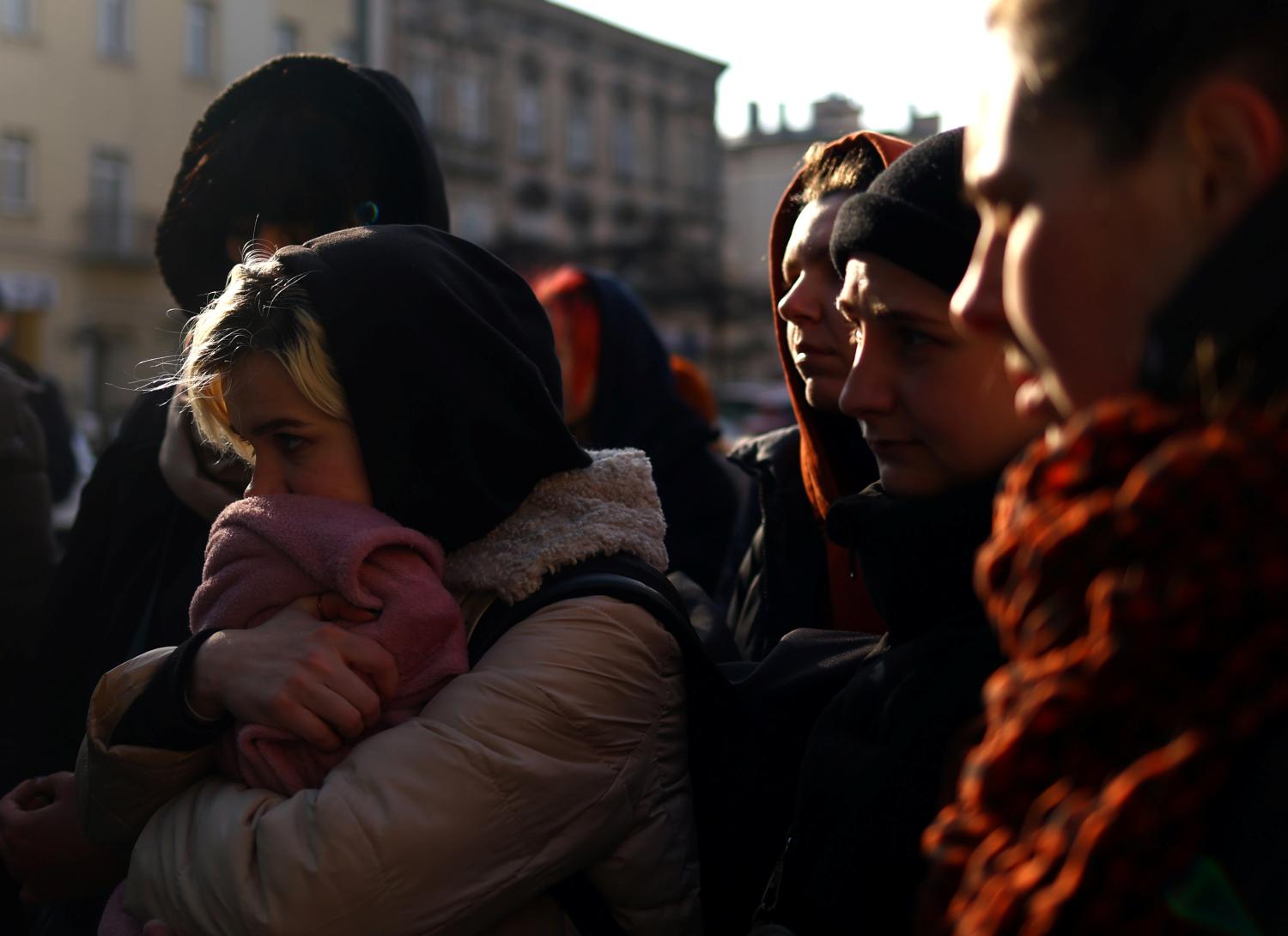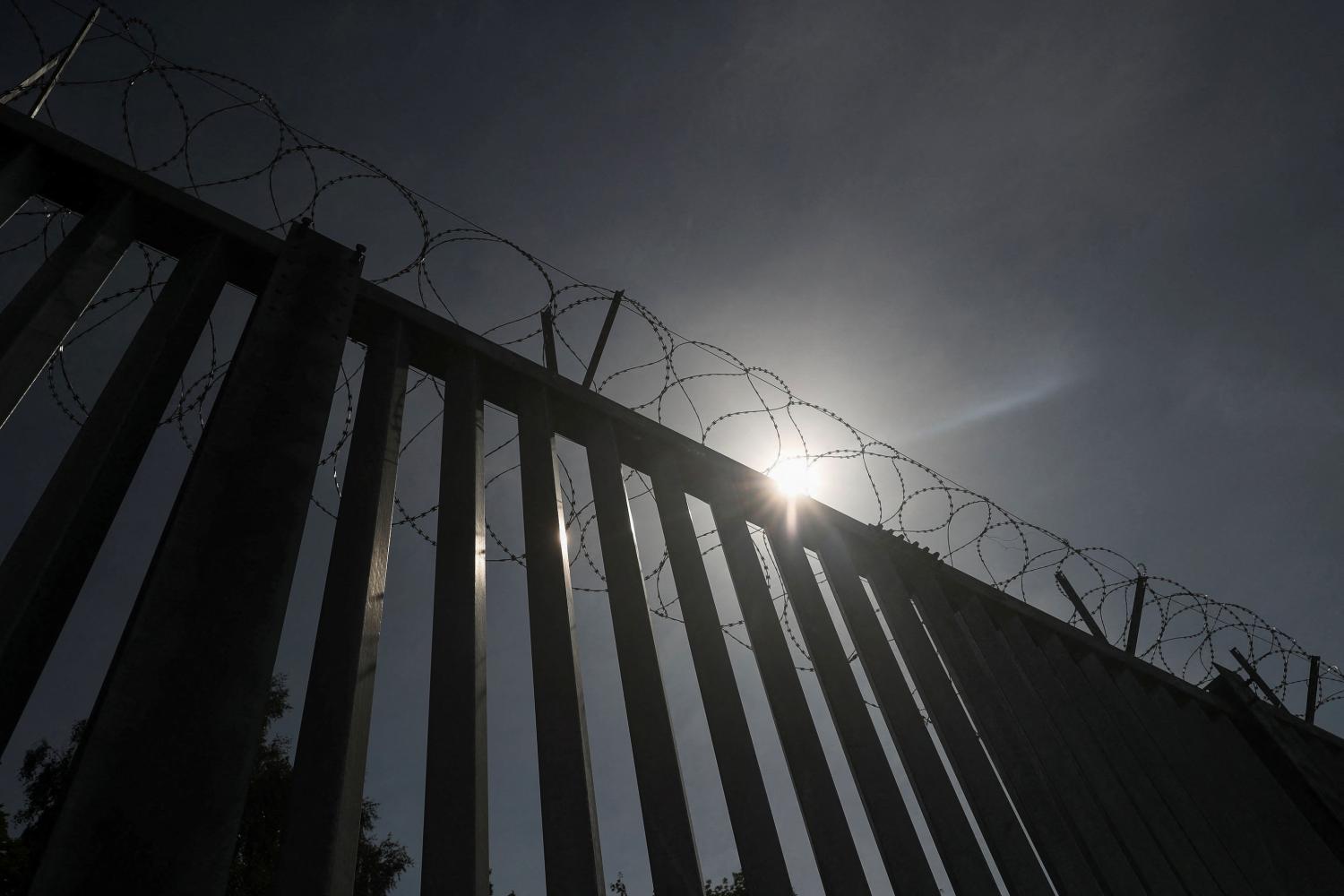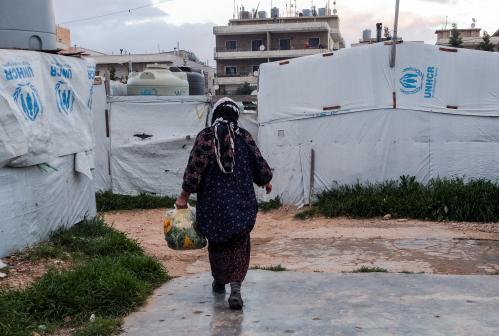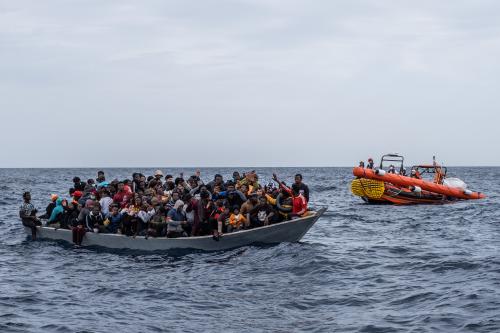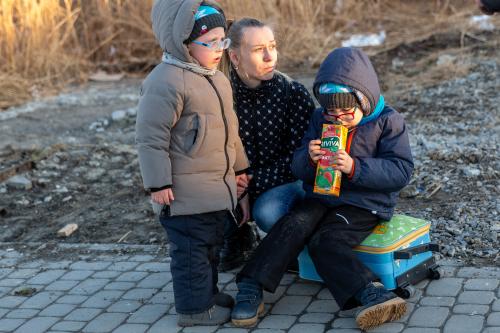This piece is part of a series of policy analyses entitled “The Talbott Papers on Implications of Russia’s Invasion of Ukraine,” named in honor of American statesman and former Brookings Institution President Strobe Talbott. Brookings is grateful to Trustee Phil Knight for his generous support of the Brookings Foreign Policy program.
Located next door to the raging war in Ukraine, Poland has become a new focal point of migration in Europe. According to the United Nations High Commissioner for Refugees (UNHCR), almost 14 million crossings have been recorded from Ukraine to Poland since February 24, 2022, and nearly 1 million Ukrainians are currently recorded as refugees in the country of nearly 38 million inhabitants. As of August 8, the UNHCR registers approximately 4.6 million Ukrainian refugees across Europe (excluding Russia). The European continent has not seen such levels of displacement — in both speed and scale — since World War II. In the wake of the Russian invasion, both the Polish government and civil society welcomed Ukrainian refugees with open arms and massive support efforts. The European Union’s Temporary Protection Directive, adopted just days after Russia’s attack, further facilitated the humanitarian response by granting Ukrainians immediate legal status to reside in member states and rights to access services.
Just a few months earlier, however, thousands of migrants and asylum-seekers from Africa and the Middle East were left stranded in the forest separating Poland and Belarus, forcefully turned away by Polish border guards at the gates of the European Union. The Belarusian government began weaponizing migrants as a political tool in mid-2021, resulting in several thousand individuals primarily from Iraq and Syria arriving to enter Poland, Lithuania, and Latvia via Belarus in order to seek asylum in countries within the EU. Rather than offering safety, however, the Polish government announced a state of emergency and constructed a 186-kilometer border wall to thwart any crossing attempts. The emergency order also denied aid workers, journalists, and civil society groups access to the border area and criminalized any effort to help migrants trapped in the forest.
The about-face in policy toward asylum-seekers is not unique to Poland. Since the start of the Russian invasion of Ukraine, analysts have highlighted the sharp discrepancy between the treatment of Ukrainian and non-Ukrainian asylum-seekers. At land borders and at sea, migrants and asylum-seekers seeking to reach Europe from North Africa and Turkey continue to be forcefully turned back in now-commonplace violations of EU and international law. On June 14, 2023, for example, over 500 asylum-seekers and migrants were estimated to have lost their lives in a single shipwreck in the central Mediterranean as the Greek coast guard watched.
Even after asylum-seekers arrive, Europe’s disparate policies have concrete implications at the local level for the towns and cities hosting refugees, asylum-seekers, and migrants. Amidst persistent global conflicts, worsening climate change, and the economic fallout of the pandemic and the war, Europe saw the number of non-Ukrainian asylum applications increase to over 900,000 in 2022 — levels not seen since 2016. Yet support for non-Ukrainian asylum-seekers has been hindered by a lengthy asylum process, relatively lower civil society and political resources compared to the Ukrainian response, and staffing and housing shortages.
In June, the Council of the European Union announced an initial agreement as part of negotiations on a broader pact on asylum and migration management. The proposal includes expanded border detention centers and a procedure whereby asylum-seekers would be relocated to cities and towns in EU states less exposed to migration. It also proposes EU states would pay up to 20,000 euros per asylum-seeker if they refuse to accept such relocations. The next step will be negotiations between the council and the EU Parliament. Observers have argued that the proposal is overly focused on border enforcement and detention and does little to build off the positive lessons of the Ukraine response. Even if approved, however, the pact would reportedly not enter into force until 2026.
Research and the successes of the Ukrainian response have shown that asylum-seekers and refugees can contribute to local economies and societies if given the right support, particularly as countries across Europe grapple with aging workforces and labor shortages. As policymakers work to design migration and asylum policy in Europe, the legal frameworks, political will for solutions, and civil society mobilization for Ukrainian refugees can provide a roadmap for improving policies for refugees and asylum-seekers in Europe more broadly.
Demographic and socioeconomic factors shape unique vulnerabilities
Under European and international law, states have an obligation to uphold the right of individuals to seek asylum regardless of their country of origin. The 1951 Convention Relating to the Status of Refugees and its 1967 Protocol — of which all EU members are signatories — obliges states to accord protection to all individuals with a “well-founded fear of being persecuted for reasons of race, religion, nationality, membership of a particular social group or political opinion.” National origin legally cannot be a basis for discrimination in the asylum process. The different demographics, educational backgrounds, experiences of violence and displacement, and the journey to Europe nevertheless all shape refugees and asylum-seekers’ local integration experiences and access to the labor market and must inform government policy facilitating integration once refugees and asylum-seekers arrive.
Ukrainian refugees displaced by the war differ in several respects from previous groups of asylum-seekers seeking protection in Europe. Men aged 18-60 years have been prohibited from leaving the country due to martial law. A UNHCR monitoring exercise conducted between October 2022 and August 2023 found that 85% of members of households interviewed are women and children.1 About one-third of household members are minors under 18 years of age, among whom approximately 80% are school-aged children between 5-17 years and 20% infants between 0-4 years. Of all households interviewed, 44% include at least one school-aged child and 15% include at least one infant. The Ukrainians interviewed also have high levels of educational attainment: almost 50% completed tertiary education, including postgraduate degrees, and an additional 29% underwent vocational training. Prior to leaving their homes, over half of Ukrainian refugees were employed. Ukrainians also overwhelmingly carry a national identity document. A prior version of the UNHCR’s survey (conducted from May to November 2022) found that 74% of interviewed Ukrainians had a biometric passport, enabling rapid registration for protection and benefits under the Temporary Protection Directive. Finally, due to proximity and remaining ties at home, 26% of Ukrainians residing in neighboring countries have visited Ukraine at least once since their initial departure.
In contrast, the almost 1 million non-Ukrainians who applied for asylum in the EU in 2022 are of diverse national backgrounds and demographic composition. People who sought asylum came from countries across the globe, with Syrians and Afghans representing the top two nationalities at around 130,000 individuals each. The third-largest group came from Turkey, with Venezuela and Colombia close behind. Those fleeing war and persecution are arriving alongside individuals fleeing the economic fallout of the COVID-19 pandemic, slow or fast-onset environmental disasters, and fragile governments. Displacement is often multi-causal, and existing legal asylum frameworks do not provide protection for factors including climate change-induced displacement.
In terms of gender, 71% of total asylum applications in 2022 were submitted by males and 29% by females. This gender discrepancy has been attributed by researchers to factors including the extreme difficulty and danger of reaching Europe and women’s limited socioeconomic rights and resources in origin countries and first-destination countries of refuge. Over 240,000 individuals — about one-quarter of applicants — were under 18 years old, of which 59% were boys and 41% were girls. Nearly one-fifth of children arrived unaccompanied by a parent or legal guardian. Finally, identity verification is a key requirement in establishing protection needs and accessing support services, especially country of origin and age. The absence of travel and identity documents upon arrival — due to displacement conditions or incidents during the journey — can often prolong the review process. In Germany, for example, the proportion of asylum-seekers without official documentation has decreased in recent years, though approximately 45% of applicants in 2021 still lacked passports or ID cards.
Studies of the 2015-16 European refugee crisis found that educational background varied widely across countries of origin. In Germany, for example, a study conducted in 2015 found that greater proportions of asylum-seekers from Iraq and Syria held tertiary degrees than other groups, and a majority had attained secondary education. Monitoring surveys conducted in 2016 and 2017 on the Eastern Mediterranean route (Serbia, Greece, North Macedonia, and Hungary) by the International Organization for Migration (IOM) found a lower level of educational attainment for irregular migrants and asylum-seekers across all countries of origin compared to Ukrainian refugees. Over 50% of respondents interviewed held secondary degrees, while approximately 16% had attained tertiary education and approximately 6% had no formal education. However, this data does not reflect the educational profile of asylum-seekers and migrants arriving in 2022 and 2023. Overall, irregular migrants and asylum-seekers arriving in Europe have often attained higher educational levels than non-migrants from their countries of origin.2
These demographic and socio-economic differences between Ukrainian and non-Ukrainian refugees and asylum-seekers shape migrants’ specific vulnerabilities and needs, which in turn affect the formulation of adequate reception and integration policies. The Organization for Economic Co-operation and Development (OECD) has highlighted that female-led refugee households face significant challenges due to the double burden of childcare and economic support. Research shows that women and children refugees are also more vulnerable to exploitation and abuse. At the same time, Ukrainians’ high level of educational attainment and diasporic connections have likely facilitated their labor market integration amid European worker shortages. For non-Ukrainian asylum-seekers, documentation challenges and the broad range of displacement reasons present barriers during the asylum process. After receiving asylum status, lower educational attainment and smaller diasporic networks are factors in accessing employment.
Among the key differences between Ukrainian and non-Ukrainian refugees and asylum-seekers have been the divergent EU and national legal frameworks and political and societal mobilization that have met these two populations.
Yet while these factors play a role in integration, the European Union and its constituent governments hold the legal responsibility to protect all refugees seeking protection. As examined below, among the key differences between Ukrainian and non-Ukrainian refugees and asylum-seekers have been the divergent EU and national legal frameworks and political and societal mobilization that have met these two populations. For Ukrainians, these frameworks and support have substantially mitigated the challenges faced by vulnerable groups including female-headed households. For non-Ukrainians, the current asylum process often exacerbates challenges facing asylum-seekers and communities, and support after asylum is insufficient in helping integration.
Where there’s a will, there’s a way: Europe’s response to Ukrainian refugees
The response to Ukrainian displacement in Europe was both historic and unique. Within two weeks after Russia’s full-scale attack, over 1.5 million refugees had crossed into Poland via the Polish-Ukrainian border. The speed and scale of the exodus led the European Union to adopt the Temporary Protection Directive (TPD) for the first time since its establishment in 2001. Originally developed in the wake of the Yugoslav Wars to provide emergency protections in instances of mass displacement, the directive had never been triggered, even during the sharp increase in refugees and asylum-seekers fleeing Syria and other war-torn countries in 2015. On March 4, 2022 — eight days after the Russian invasion — the European Union invoked the directive, granting Ukrainians who apply for the TPD immediate legal status to reside in member states and rights to access housing, employment, education, and social services. At the level of civil society, Europeans quickly mobilized to support refugees. A combination of political will and social solidarity enabled a remarkably effective reception of refugees in the days and weeks after the outbreak of the war.
Politically, the EU directive was a crucial mechanism for national governments to accept and accommodate Ukrainian refugees in a short time with minimal bureaucratic hurdles. The immediate provision of legal status avoided long backlogs in already-stretched asylum systems. Authorizations to seek employment and education and access to housing as well as social and medical benefits at least in principle created the possibility for Ukrainians to settle quickly in their host countries. National governments published websites in Ukrainian with information on how to register for temporary protection and access services and expanded opportunities for learning the host country’s language.
At the civil society level, not only were Ukrainians perceived as fellow Europeans, but the attack on Ukraine was viewed as an affront to Europeans’ own democratic way of life and a threat to their future security. The large Ukrainian diaspora of over 1.5 million legal residents predating the full-scale war also played an instrumental role in the massive mobilization efforts. Local organizations and private individuals — even beyond Ukraine’s neighbors — raised money and coordinated rides to the border to transport people to specific locations and welcome centers. Refugees who had existing networks often moved in with their contacts, and private households signed up to open their homes to strangers as host families. Others stayed temporarily in collective reception sites but were generally moved quickly into houses or apartments rented by local governments. An OECD survey conducted between April and August of 2022 suggested that over one-quarter (27%) of Ukrainian refugees lived in private households, including 19% who lived with family members. Another 18% stayed in private rented accommodation and only 14% remained in reception centers. Many Europeans also helped indirectly, donating money, food, and clothing to support Ukrainians in their communities.
Challenges remain for Ukrainians and local host communities
Despite the unprecedented legal and political frameworks and the positive societal reception, the response to Ukrainian displacement has not been without challenges — for national and municipal governments, host communities, and Ukrainians themselves. First, the legal framework provided by the TPD at the EU level still left national governments responsible for implementation, leading to discrepancies in the accessibility of rights and benefits across different states. Granting Ukrainians the freedom to choose where to settle led to a greatly unequal distribution of refugees across and within EU states. In early August 2023, the UNHCR recorded the highest numbers of Ukrainian refugees in Poland, Germany, the Czech Republic, Spain, and Italy across the EU. This correlated with the largest diaspora communities across Europe prior to the war present in those five countries.
Though many Ukrainian children initially continued their education from home via Zoom, localities scrambled to offer sufficient enrollment opportunities in local kindergartens and schools, as granted by the TPD. This entailed not only creating physical classroom space but also helping them understand content and learn the host country language in schools. In Poland and Germany, the two largest hosting countries, this came against a backdrop of existing teacher shortages. Host cities were similarly challenged to offer enough language courses for adults, a prerequisite for finding employment and integrating into community life. For locals who opened their homes to refugees as host families, the prolonged conflict and future uncertainty continued to strain private assets.
Stuck in a state of limbo, [Ukrainian refugees] try to navigate a viable path between integrating into host communities and maintaining the goal of returning home.
Ukrainians nevertheless face significant hardships despite Europe’s unprecedented warm welcome. Where shortages of language courses existed, refugees were unable to access opportunities to qualify for jobs or continue their education. Absent child care, adults were further hindered in seeking employment. Yet even when language and child care were established, strict regulations in select host countries prevented Ukrainians from accessing work in accordance with their qualifications. Nevertheless, some countries have taken advantage of the refugees’ presence to address labor shortages in key sectors. For example, Poland has launched an initiative to facilitate the integration of qualified Ukrainian refugees into its understaffed health and medical sector, which could serve as a template for other sectors and other European countries.
Finally, the psychological burden of displacement and violence weighs heavily on Ukrainians. Many families remain separated, as men aged 18-60 years are prohibited from leaving the country and those groups with special vulnerabilities face difficulties in leaving their homes. For refugees living in Europe, coping with and processing their war experiences as well as planning for an uncertain future are paramount mental struggles. Stuck in a state of limbo, they try to navigate a viable path between integrating into host communities and maintaining the goal of returning home.
Increasing arrivals to Europe amidst a sharp rise in forced displacement globally
While the shock of the Ukraine war and the displacement triggered by it dominated public discussions last year, Europe also saw near-record numbers of non-Ukrainian asylum applications and irregular arrivals. Excluding Ukrainians covered under the TPD, almost 1 million people applied for international protection in 2022 across the EU — an increase of over 60% compared to 2021 and the highest since 2016. The IOM reported that over 189,000 migrants and asylum-seekers arrived irregularly by land and sea in 2022 — also the highest since 2016. Arrivals for the first half of 2023 are already 54% higher than in 2022.
A key cause of asylum applications and irregular arrivals to the EU is dramatically rising global forced displacement over the past decade and the expansion of existing and new migration routes through North Africa, particularly Libya and Tunisia. The number of people forcibly displaced globally surpassed 100 million in 2022. By the end of 2023, the UNHCR estimates that number will reach over 117 million, with roughly half of those internally displaced and half displaced across international borders. Whereas 1 in 167 people were displaced in 2012, 1 in 77 were in 2022. Conflict, violence, persecution, human rights violations, and political turmoil remain the top drivers of displacement. Worsening climate change, inflationary macroeconomic shocks such as the COVID-19 pandemic and the Russian invasion of Ukraine, and flagging domestic economies helmed by debt-burdened governments are also all driving food insecurity and poverty that in turn contribute to rising internal and external migration.
Scholars and analysts have described current movements to Europe as “mixed migration” due to the different legal statuses of people arriving. Indeed, unlike those individuals who are fleeing conflict and persecution and thus have the right to asylum under the 1951 Refugee Convention and EU and domestic laws, others may not be afforded such rights. For example, people who are migrating in search of better livelihoods or who have been displaced by climate change and natural disasters may be protected under international human rights law, but they do not necessarily have access to asylum.
In response to heightened numbers of arrivals of refugees primarily fleeing war in Syria, Iraq, and Afghanistan along with other asylum-seekers and migrants in 2014 and 2015, the EU implemented restrictive border enforcement measures and increased its aid and enforcement support to transit countries such as Turkey and Libya. While Europe promised to also expand safe migration and refugee resettlement pathways, such promises largely failed to materialize. Irregular arrivals subsequently declined from over 1 million in 2015 to fewer than 190,000 in 2017. Yet even with intensified enforcement and funding for often-abusive detention centers in Libya, migration to Europe through Libya and Tunisia has been sharply increasing since 2019. These routes, part of the broader Central Mediterranean route, are notoriously deadly. Even prior to the June 14 shipwreck, the UNHCR estimated that 1 in 6 people departing North Africa die on their journeys. With few other options, however, arrivals through this route are set to outpace 2022.
Non-Ukrainian asylum-seekers arriving in Europe over the past year faced a wholly different reality than Ukrainian refugees. The greatest challenge for people seeking protection not covered by the TPD remains the complex and dysfunctional legal framework. On paper, the Common European Asylum System (CEAS) establishes EU-wide standards regarding the processing of applications, conditions of reception, and qualifications for protection. Moreover, the Dublin Regulation lays out a mechanism that assigns responsibility for asylum-seekers to their first EU country of arrival. In practice, however, many asylum-seekers who originally set foot in outer-EU states continue their journeys throughout the bloc — warranted by free movement across borders within the Schengen Area — into inner-EU countries before registering with national authorities, contrary to Dublin. Since the 1990s, the bloc has unsuccessfully tried to create a functional EU-wide refugee distribution mechanism. Some countries have internal systems that assign asylum-seekers to different regions, accounting for the size of the native population and economic capacity, such as the “Königstein Key“ in Germany. The recent EU agreement for a new asylum and migration pact envisions such a distribution mechanism that divides the responsibility of hosting asylum-seekers more equally across member states. It also includes a provision that offers countries to opt out of hosting in exchange for a 20,000-euro payment per individual into a common fund. Nonetheless, Poland and Hungary have already voiced objections, raising questions over whether negotiations between the council and the Parliament can successfully transform the proposal into law.
As with the TPD, implementation disparities exist across EU countries with respect to the provision of reception services, availability of integration offerings, and general treatment of and attitudes towards asylum-seekers during and after the review process. Research shows that refugees prefer certain destinations over others, based on a combination of family and network ties, previous levels of asylum applications in the country, the perceived openness toward newcomers, and accessibility of support services and labor market opportunities. As a result, many countries in northwestern Europe have witnessed disproportionate arrivals of asylum-seekers. Over the last decade, Germany has been the largest receiving country in the EU, with over 240,000 asylum applicants in 2022 — on top of over 1 million Ukrainians arriving under the TPD. Hungary, by contrast, has pursued a strict “zero refugee“ policy and passed contested laws preventing people from seeking asylum in the country and instead outsourcing the procedure to Hungarian embassies abroad, violating international and EU law. At the forefront of increasing arrivals, however, several southern European countries — most notably Italy, Greece, and Spain — also are facing serious strains on their local reception capacities, resulting in demands for more solidarity and collective “burden-sharing” across the EU.
Dysfunctional policies foil effective support and integration of non-Ukrainian asylum-seekers
Complex national legal frameworks around the asylum process, lower collective civil society and political resources compared to the Ukrainian response, and severe local housing and staffing shortages all threaten the current response for non-Ukrainian asylum-seekers. For the EU, the focus has been on securitization of borders and removal of irregular migrants and asylum-seekers, rather than protection of rights and physical safety. While there is wide variation between host countries, current policies broadly fail to adequately support individuals both during the asylum process and once they have achieved refugee status in building lives and integrating.
First, the asylum process itself differs sharply from the immediate legal protections extended to Ukrainians. As arrivals and applications increased, national authorities have struggled to expand their adjudication capabilities, creating a backlog of total pending cases that reached 877,725 by the end of 2022. Across Europe, insufficient staffing within asylum processing offices over the years has prolonged waiting times and squeezed resources for service provision. During the review and even when asylum claims are recognized, severe shortages in social workers prevent asylees from receiving adequate legal advice and accessing protection and integration measures, starting with language courses and extending to counseling and community engagement.
Second, finding housing spaces presents one of the biggest challenges at the local level of host municipalities. Unlike Ukrainians, most other asylum-seekers are accommodated in collective shelters pending review of their applications. Depending on the host country, these may vary from empty group homes or gymnasiums divided by cardboard walls into small cubicles with bunk beds to small container or tent villages, as is often the case in Germany. In the worst cases, asylum-seekers reside in unprotected outside encampments or detention-like prisons, as recently uncovered in Hungary, Bulgaria, Croatia, and Greece.
Asylum-seekers thirdly face barriers to the labor market both while waiting for asylum decisions and after asylum is approved. The CEAS generally prohibits asylum-seekers from obtaining work permits for the first nine months after filing an application or until a positive asylum decision has been granted, with the intent to limit economic migration. Some countries have shortened this wait to six or three months. Other national limitations include the condition that no native or permanent resident of the host country could fill the job, restrictions on employment access for asylum-seekers arriving from “safe third countries” until a positive decision has been granted, and benefit reductions proportional to employment earnings. Beyond legal restrictions, studies show that long waiting times in the asylum procedure negatively affect the chances of employment for refugees in the year after receiving protection status, not least because of the psychological impact.
Even if asylum-seekers are not repatriated, a sharply increasing proportion of asylum-seekers — including from Syria and Afghanistan, which continue to face protracted violence and wars — are being granted subsidiary protection rather than refugee status. Within the EU, subsidiary protection is applied to individuals who governments argue do not meet the 1951 Convention definition of a refugee, yet who still face a serious threat of harm in their home country. Individuals who receive subsidiary protection must generally apply for residency renewal more frequently, creating additional bureaucratic burdens. For example, in Austria, subsidiary protection residency permits are valid for one year compared to three years for refugee status, while in France subsidiary protection recipients have four-year residency permits compared to 10 years for refugees. In some countries, such as Greece, having subsidiary protection instead of refugee status prevents individuals from applying for family reunification.
Individuals who receive either refugee status or subsidiary protection face additional barriers to integration and accessing employment. Research has found that national dispersal policies constitute an impediment to successful labor market integration, with asylum-seekers and refugees sometimes located in rural areas with weak local labor markets. Language barriers, lack of information and recruitment support, recognition of qualifications, and remote locations of accommodation centers further hinder asylum-seekers and refugees’ efforts to acquire employment.
Non-Ukrainian asylum-seekers and refugees are frequently physically and psychologically impacted by both displacement and their experience in hosting countries — ultimately affecting integration.
Non-Ukrainian asylum-seekers and refugees are frequently physically and psychologically impacted by both displacement and their experience in hosting countries — ultimately affecting integration. First, the long asylum procedure timeline condemns refugees to a prolonged state of uncertainty about whether they will be given protection status or sent home, prompting anxiety and mental stress. Second, when stuck in over-securitized or under-resourced encampments, asylum-seekers in many EU border countries are often at risk of violence and exploitation and are deprived of basic hygiene conditions and medical support. Even in more stable collective houses, gymnasiums, or containers, the lack of privacy, restless communal environment, and overcrowded spaces amplify psychological distress. For years, human rights organizations have criticized that standards of reception and accommodation of asylum-seekers undercut basic human dignity. Finally, research has shown that delays in family reunification create heightened incidences of mental disorders, inhibiting integration.
Notably, societal attitudes in host communities also differ with respect to non-Ukrainian asylum-seekers coming primarily from the Middle East, South Asia, and Africa. Racial and religious bias — conscious and unconscious — have contributed to the more frigid reception of non-Ukrainian asylum-seekers. Further, the economic and geopolitical consequences of the war in Ukraine directly affected Europeans, creating sympathy and giving them a stake in the Ukrainians’ cause, whereas the drivers of non-Ukrainian displacement are more distant. The sharp increase in asylum-seeker arrivals across Europe in 2015 and 2016 initially generated significant government and civil society mobilization to provide resources for newcomers, particularly after the highly publicized photo of two-year-old Syrian refugee Alan Kurdi’s body on a Turkish shore in September 2015. Yet the response varied widely across Europe, and even positive mobilization diminished or was met with the counter-mobilization of civil society groups opposed to the arrival of asylum-seekers. The current relatively weaker social mobilization for non-Ukrainian asylum-seekers has had concrete implications for both pressure on governments for political action and resources and resulted in lower complementary civil society support — support that has been key in helping Ukrainian refugees.
The TPD as a guide for reforming Europe’s asylum policy
Since the start of the Ukrainian refugee crisis, observers have highlighted Europe’s “double standard” toward Ukrainian and non-Ukrainian refugees and asylum-seekers. While Ukrainians were swiftly greeted with expansive legal protections, asylum-seekers from countries such as Syria who have also fled the horrors of war and repression were not met with similar policies even at the height of the Syrian civil war in 2015. The current patterns of non-Ukrainian arrivals and asylum applications are more mixed compared to 2015 and 2016. Climate change and environmental disasters are increasingly contributing to displacement alongside violence, persecution, and economic challenges — but legal frameworks have yet to catch up with this new reality.
Equitable treatment does not mean a suspension of asylum adjudication processes. Instead, analysts and advocates have argued that it means applying the principles that have driven the Ukraine response of viewing protections for individuals fleeing conflict and repression as part of Europe’s responsibility both under international law and the democratic norms of inclusion it espouses. All EU countries — with the exception of Hungary — committed to the U.N. Global Compact on Refugees in 2018. While not legally binding, the compact aims to strengthen solidarity among host countries and adequate conditions to foster refugees’ independence and self-reliance and reflects the urgency and benefits of more inclusionary policies toward refugees and asylum-seekers. Yet at land and at sea, European countries regularly push back non-Ukrainian asylum-seekers regardless of the potential validity of their claims. The legal rights of asylum-seekers once they arrive in many countries across Europe — such as Poland — stand in stark contrast to the mass political and social mobilization that has met Ukrainian refugees.
As this brief demonstrates, however, the effects of this disparity extend beyond Europe’s failure to adhere to its own pluralistic values and violations of human rights and international law at borders. They have concrete consequences for localities struggling with the implementation of national-level frameworks and for local economies and asylum-seeker integration. During the asylum application stage, the prevalence of detention centers, staffing shortages for asylum application processing, and limitations on asylum-seekers’ ability to work create deep burdens for asylum-seekers themselves and challenges for localities. After an asylum application is approved, unequal fiscal resources for housing and relatively limited civil society and social worker support services facilitating asylum-seeker access to the labor markets all hinder integration and strain local service systems.
Lessons from the experiences of asylum-seekers following the 2015 European refugee crisis and the successes of the Ukraine refugee response offer a policy roadmap to improve Europe’s approach to migration, asylum, and integration.
First, discussing the future of asylum in Europe requires recognizing that migration policies adopted at national and international levels are realized at the local level. The disconnect between policy design and execution leads to challenges in local host communities to respond effectively to large-scale arrivals of people seeking protection, especially if the legal frameworks and available support are distinct for different refugee and asylum-seeker populations within the same country. Bridging this divide requires an active role for municipal and local host governments, civil society, and refugee leaders in communicating the specific challenges they face and informing policy. This includes actions such as increasing local input on building initiatives to address severe local affordable housing shortages in many localities across Europe. In a 2020 policy brief for the European Migration and Diversity Programme, researchers including Brookings event speaker Petra Bendel highlighted how local leaders are already informing policy through city networks and ad hoc collaboration with national and EU actors and called for formally institutionalizing policy input mechanisms.
The Ukrainian response and previous research secondly demonstrate the strong connection between the asylum adjudication process and local integration. The psychological and skills loss impacts of detention centers, long delays in asylum processing, the experiences of living in substandard or even unsafe collective housing, and limited access to social workers all factor into asylum-seekers’ experiences of integration once refugee status is granted. The current EU proposal to detain asylum-seekers for months in border facilities as part of the new asylum process is not grounded in evidence of detention’s significant negative impacts. Instead, as many organizations such as the European Council on Refugees and Exiles have argued, building on what has worked in the Ukrainian context, such as the rapid legal temporary status process and securing less crowded housing facilities, will ultimately benefit both refugees and communities. Decisions on legal status allow localities to progress on issues of employment, education, and service allocation. Extending the purchase and provision of private residential facilities by municipalities, as dominant in the Ukrainian response, to non-Ukrainian asylum-seekers would further benefit local administrators in securing long-term affordable housing spaces, even beyond temporary migrant influxes.
Third, there is no “one-size-fits-all” formula for facilitating local inclusion and integration. Age, gender, family and medical status, language and cultural background, and reasons for fleeing their country of origin all shape what conditions asylum-seekers find themselves in, the challenges they face, and what support they require in host communities. In the Ukrainian response, factors including the large diaspora and language training along with the ability to settle in locations of their choosing helped early community inclusion efforts. While many non-Ukrainian refugees also have existing and growing diasporas, such as Syrians in Germany, distribution policies place individuals and families in communities where they often have no existing ties. In a policy brief, researchers from the Migration Policy Institute highlighted the importance of both early and sustained forums for refugee-host community interaction, particularly in rural areas with less racial and national diversity. Investing additional resources in these forums and expanding civil society outreach, including to groups that are working primarily with Ukrainian refugees, is a concrete action national and local governments can take.
Fourth, fostering inclusion and integration also means facilitating asylum-seekers and refugees to lead community-building efforts and engage in the labor market. In the case of Ukrainian refugees, immediate legal status, proactive efforts at job matching, private sector-public partnerships, and extensive education and language training opportunities have all helped quick labor market entry. An IOM survey of Ukrainian refugees found that language was the key barrier to work, while education level did not correlate with employment levels. While there is wider variation within the EU in opportunities for non-Ukrainian refugees, support programs have also recorded success. In Sweden, a two-year program for refugees helps them with intensive language training and work placement. Expanding such programs and reducing or eliminating wait times for labor participation for asylum-seekers and refugees is key, particularly given the severe labor shortages in countries across Europe.
Fifth, pursuing a functional “dual intent” policy is critical for host governments, for both Ukrainian and non-Ukrainian refugees and asylum-seekers. For Ukrainians, governments must guarantee protection and successful integration as the war continues, while also implementing structures to facilitate refugees’ return upon the war’s end. Return will be a crucial part of Ukraine’s future economic and societal reconstruction — the country was already facing an aging population and diminishing labor force before the war. Some observers have argued that the arrival of Ukrainian refugees cannot be viewed as a sustainable solution to labor market challenges. Yet as the lessons of many previous refugee crises have shown, the causes of displacement can extend for years, decades, or an entire lifetime. Premature attempts at return, as in the case of Denmark attempting to refoul Syrian refugees, cause direct harm and create a broader environment of fear and uncertainty for refugees navigating life in their host societies. The EU must take a strong stand against the premature repatriation of refugees by its member states.
Finally, as many have argued, EU asylum policy should extend beyond borders to expand safe pathways for refugees and asylum-seekers and help them avoid the trauma of deadly journeys and smuggler abuse. Researchers such as Jeff Crisp have highlighted the lack of evidence on the causal connection between expanded safe pathways and reducing irregular migrant and asylum-seekers arrivals — in part because so few pathways have been introduced. Expanding refugee resettlement and complementary programs such as labor visas that help individuals reach Europe from both origin countries and first-destination countries of refuge will not stop irregular arrivals completely. Nor are they a substitute for the right to claim asylum under international law. But expanded refugee resettlement will help localities plan more effectively around refugee arrivals and ensure the most vulnerable — such as women and families — who often cannot undertake the journey to Europe can access protection. Many promised pathways, such as in response to the 2021 Afghan refugee displacement, have not been implemented. Refugee resettlement should be significantly increased, along with complementary programs such as Talent Partnerships that create labor and education mobility pathways for non-EU countries.
As negotiations continue over the new migration and asylum pact, Europe has a chance to build a better future for asylum and refugee integration policy...
There are few signs that the causes of growing global forced displacement and mixed migration will abate in the near future. Ongoing violence and persecution in countries such as Syria and Afghanistan will prevent many from returning home, and recently intensifying violence in Sudan has displaced millions. Many refugees, such as Syrians in the Middle East, are facing intensifying pressure to leave the countries neighboring Syria where they have sought shelter, and in surveys are expressing increased desires to migrate to Europe and other destinations. Climate change, economic inequality, and weak domestic governments and economies are pushing many more to leave their homes in search of better lives. The recent suspension of the U.N. and Turkey-brokered Black Sea Grain Initiative (BSGI) and Russian attacks on Ukrainian ports threaten to once again limit commodity supplies and raise global food prices, worsening already-dire international food insecurity. The U.N. World Food Program sourced 80% of its wheat from Ukraine when the deal was terminated. This grim global picture only underscores the need for Europe to formulate a functional policy that accounts for the humanitarian dimension of displacement rather than focusing on detaining and pushing asylum-seekers back.
As negotiations continue over the new migration and asylum pact, Europe has a chance to build a better future for asylum and refugee integration policy that supports both asylum-seekers and refugees as well as local communities across Europe with aging populations and growing labor shortages. The Ukraine response has demonstrated the power of collective political and social will in welcoming a population fleeing the violence of war. European policymakers must keep these lessons in mind and the extensive research that shows that asylum-seekers and refugees can positively contribute to European societies and build lives for themselves if given support and protection.
-
Acknowledgements and disclosures
The authors would like to thank Adam Lammon for editing and Rachel Slattery for graphics and layout.
-
Footnotes
- The UNHCR monitoring survey of refugees from Ukraine is based on interviews with approximately 41,862 respondents between October 2022 and August 2023. According to the UNHCR, while respondents were randomly selected to reduce bias, non-probability sampling is used, and results cannot be necessarily extrapolated to the broader refugee population. In general, due to the limited availability of reliable data on Ukrainian refugees and non-Ukrainian asylum-seekers, the demographic numbers cited in this brief are estimates.
- Detailed surveys on the educational profiles of individuals seeking asylum in Europe in 2022 are not yet available. As arrivals are significantly more mixed now than in 2015/16, with fewer Syrians overall and increasing numbers from South America and South Asia, the educational profiles of asylum-seekers may have changed as well.
The Brookings Institution is committed to quality, independence, and impact.
We are supported by a diverse array of funders. In line with our values and policies, each Brookings publication represents the sole views of its author(s).


